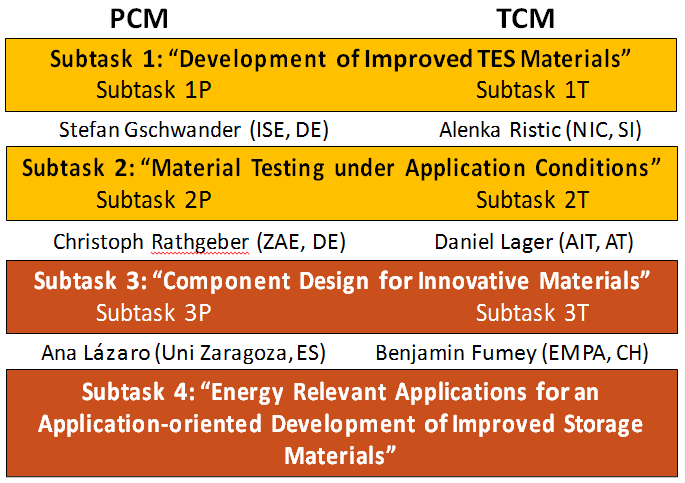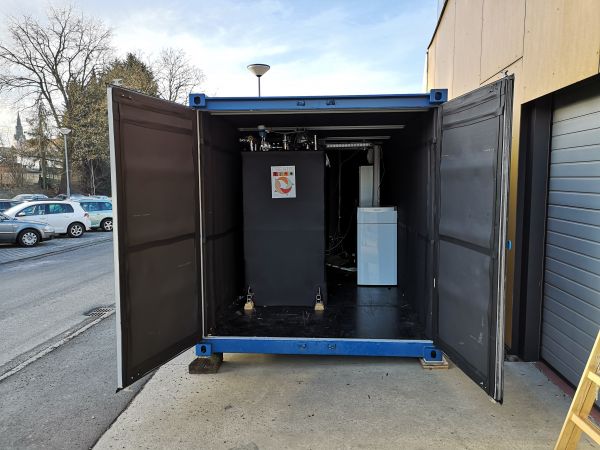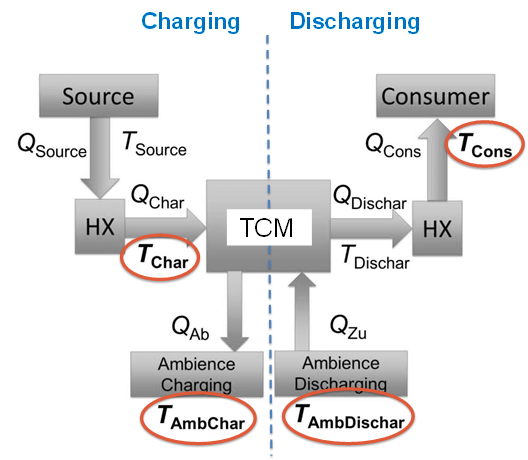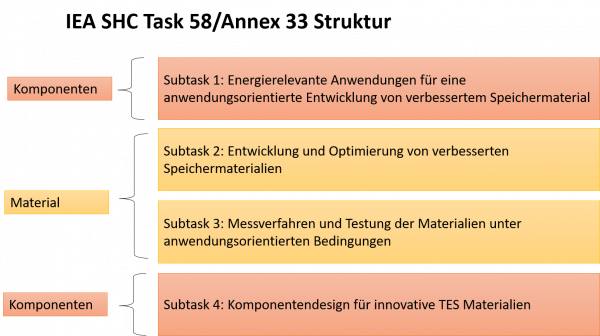IEA SHC Task 58/ECES Annex 33: Material and Component Development for Thermal Energy Storage
Short Description
Working groups are active worldwide in the field of material development for heat storage and applications for thermal storage. These activities usually focus on specific applications, technologies or materials. The main task of the task was to bring these activities together and integrate them into a unified development plan.
The main goals were:
- Development and characterization of storage materials that can be used to improve thermal energy storage
- Development of material test procedures and characterization methods, including material tests under real conditions
- Development of components for compact thermal storage systems
- Classification and evaluation of the chances of thermal storage applications including the requirements of the storage material
The work in the Task was divided into different subtasks, see the following figure:
Due to the different characteristics of phase change and thermochemical materials, the work in the Task/Annex was conducted in two parallel tracks, indicated with a "P" or a "T" in the numbering.
The goal of subtask 1 was to identify important operating parameters of relevant application areas. The data was merged as part of the activities of other Tasks and Annex. No division into PCM and TCM related applications was made here, as the results and findings are valid for all storage materials.
The goal of subtask 2 was to develop and characterize PCM and TCM to improve storage system performance, identify and measure material properties. The materials database started in Task42/Annex 24 and Task42/Annex29 was maintained and expanded.
- PCM: The goal was to design PCMs so that their properties are ideal for specific applications. This requires a fundamental understanding of the relationship between the thermophysical properties of the materials such as enthalpy, thermal conductivity, and material parameters e.g. material composition (admixture of graphite to PCM to increase thermal conductivity).
- TCM: The focus was on developing improved powdered TCM materials based on sorption (micro/mesoporous solids and liquids (hydroxides)), chemical reactions (salt hydrates and metal oxides/hydroxides), and combinations of both (micro/mesoporous solids +salt hydrates/metal).
The aim of subtask 3 was to define measurement methods for relevant material properties. For PCM, the focus was on scaling effects. Properties such as melting behaviour, enthalpy and supercooling effects are dependent on the material quantity. A method was developed that can be used to calculate the properties of large amounts of material from the measurement results of samples of small size (a few ml). The aim of the TCM development was to define a uniform procedure for testing the material properties water absorption capacity and reaction enthalpy and to test the feasibility of the test procedures of different laboratories by means of round-robin tests.
The goal of subtask 4 PCM development was to list components used in various concepts and describe ways to define and measure performance characteristics for PCM components. An evaluation of the concepts based on the targeted performance was performed.
The goal of subtask 4 TCM development was to list the components used by different concepts with a focus on heat and mass transfer in the component. Since there is usually a significant difference in measured storage capacity between material tests (a few grams) and laboratory scale including reactor setup (a few kg), the aim was to identify the reason for this difference.
Project Images
Terms of use: The pictures listed underneath the header “Project Pictures” originate from the projects in the frame of the programmes City of Tomorrow, Building of Tomorrow and the IEA Research Cooperation. They may be used credited for non-commercial purposes under the Creative Commons License Attribution-NonCommercial (CC BY-NC).
Project Partners
Projektleitung
- Wim van Helden, AEE INTEC
Projektpartner
- Daniel Lager, AIT, Wien
- Gerald Steinmaurer, ASiC/ FH OÖ, Wels
- Hermann Schranzhofer, IWT, TUGraz
- Andreas Werner, Institut für Energietechnik, TU Wien
Participants
Austria, Denmark, Germany, France, Italy, Canada, Netherlands, North Ireland , Sweden, Switzerland, Slovenia, Spain, Turkey
Contact Address
AEE INTEC
Wim van Helden
Feldgasse 19
A-8200 Gleisdorf




